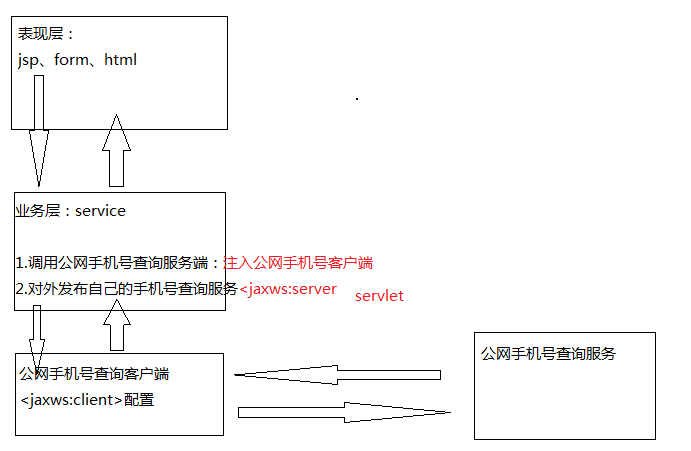1. 什么是REST
REST,英文representational state transfer(表象性状态转变)或者表述性状态转移,REST是web服务的一种架构风格,使用HTTP、URI、XML、JSON、HTML等广泛流行的标准和协议,轻量级、跨平台、跨语言的架构设计,它是一种设计风格,是一种思想,而不是一种标准。只是提供了一组设计原则和约束条件。它主要用于客户端和服务器交互类的软件。基于这个风格设计的软件可以更简洁,更有层次,更易于实现缓存等机制。
Rest要求对资源定位更加准确,如下:
- 非REST方式:http://ip:port/queryUser.action?userType=student&id=001
- REST方式:http://ip:port/user/student/query/001
REST架构的主要原则
- 网络上的所有事物都被抽象为资源
- 每个资源都有一个唯一的资源标识符
- 同一个资源具有多种表现形式(xml,json等)
- 对资源的各种操作不会改变资源标识符
- 所有的操作都是无状态的
- 符合REST原则的架构方式即可称为RESTful
2. 发布REST服务
注意:REST 不等于WebService,JAX-RS 只是将REST 设计风格应用到Web 服务开发上。
2.1 需求
发布查询学生信息的服务,以json和xml数据格式返回。
2.2 服务端
第一步:导入jar包
第二步:创建学生pojo类,要加入@ XmlRootElement
import java.util.Date; import javax.xml.bind.annotation.XmlRootElement; @XmlRootElement(name = "student") // @XmlRootElement可以实现对象和XML数据之间的转换 public class Student { private long id; private String name; private Date birthday; ··· }
第三步:创建SEI接口(主要步骤,注意注解使用)
import java.util.List; import javax.jws.WebService; import javax.ws.rs.GET;import javax.ws.rs.Path; import javax.ws.rs.PathParam; import javax.ws.rs.Produces; import javax.ws.rs.core.MediaType; import com.zang.ws.rest.pojo.Student; @WebService @Path("/student") // @Path("/student")就是将请求路径中的“/student”映射到接口上 public interface StudentInterface { // 查询单个学生 @GET // 指定请求方式,如果服务端发布的时候指定的是GET(POST),那么客户端访问时必须使用GET(POST) @Produces(MediaType.APPLICATION_XML) // 指定服务数据类型 @Path("/query/{id}") // @Path("/query/{id}")就是将“/query”映射到方法上,“{id}”映射到参数上,多个参数,以“/”隔开,放到“{}”中 public Student query(@PathParam("id") long id); // 查询多个学生 @GET // 指定请求方式,如果服务端发布的时候指定的是GET(POST),那么客户端访问时必须使用GET(POST) @Produces({ "application/json;charset=utf-8", MediaType.APPLICATION_XML }) // 指定服务数据类型 @Path("/queryList/{name}") // @Path("/queryList/{name}")就是将“/queryList”映射到方法上,“{name}”映射到参数上,多个参数,以“/”隔开,放到“{}”中 public List<Student> queryList(@PathParam("name") String name); }
第四步:创建SEI实现类
import java.util.ArrayList; import java.util.Date; import java.util.List; import com.zang.ws.rest.pojo.Student; public class StudentInterfaceImpl implements StudentInterface { @Override public Student query(long id) { Student st = new Student(); st.setId(101); st.setName("小华"); st.setBirthday(new Date()); return st; } @Override public List<Student> queryList(String name) { Student s1 = new Student(); s1.setId(101); s1.setName("小华"); s1.setBirthday(new Date()); Student s2 = new Student(); s2.setId(102); s2.setName("小黄"); s2.setBirthday(new Date()); List<Student> list = new ArrayList<Student>(); list.add(s1); list.add(s2); return list; } }
第五步:发布服务,JAXRSServerFactoryBean发布服务,3个参数,1:服务实现类;2.设置资源类;3.设置服务地址
package com.zang.ws.rest.server; import org.apache.cxf.jaxrs.JAXRSServerFactoryBean; public class StudentServer { public static void main(String[] args) { // JAXRSServerFactoryBean发布REST的服务 JAXRSServerFactoryBean jaxRSServerFactoryBean = new JAXRSServerFactoryBean(); // 设置服务实现类 jaxRSServerFactoryBean.setServiceBean(new StudentInterfaceImpl()); // 设置资源类,如果有多个资源类,可以以“,”隔开。 jaxRSServerFactoryBean.setResourceClasses(StudentInterfaceImpl.class); // 设置服务地址 jaxRSServerFactoryBean.setAddress("http://127.0.0.1:12345/user"); // 发布服务 jaxRSServerFactoryBean.create(); } }
第六步:访问即可
http://127.0.0.1:12345/user/student/query/101 查询单个学生,返回XML数据
http://127.0.0.1:12345/user/student/queryList/101?_type=json 查询多个学生,返回JSON
http://127.0.0.1:12345/user/student/queryList/101?_type=xml 查询多个学生,返回XML
注意:
- 如果服务端发布时指定请求方式是GET(POST),客户端必须使用GET(POST)访问服务端,否则会报异常。
- 如果在同一方法上同时指定XML和JSON媒体类型,在GET请求下,默认返回XML,在POST请求下,默认返回JSON。
2.3 客户端
客户端主要获取服务端发布的数据并解析
测试POST请求,将StudentInterface接口中的queryList方法声明为@POST
import java.io.BufferedReader; import java.io.IOException; import java.io.InputStream; import java.io.InputStreamReader; import java.net.HttpURLConnection; import java.net.URL; public class HttpClient { public static void main(String[] args) throws IOException { //第一步:创建服务地址,不是WSDL地址 URL url = new URL("http://127.0.0.1:12345/user/student/queryList/101"); //第二步:打开一个通向服务地址的连接 HttpURLConnection connection = (HttpURLConnection) url.openConnection(); //第三步:设置参数 //3.1发送方式设置:POST必须大写 connection.setRequestMethod("POST"); //3.2设置数据格式:content-type //3.3设置输入输出,因为默认新创建的connection没有读写权限, connection.setDoInput(true); //第五步:接收服务端响应,打印 int responseCode = connection.getResponseCode(); if(200 == responseCode){//表示服务端响应成功 InputStream is = connection.getInputStream(); InputStreamReader isr = new InputStreamReader(is); BufferedReader br = new BufferedReader(isr); StringBuilder sb = new StringBuilder(); String temp = null; while(null != (temp = br.readLine())){ sb.append(temp); } System.out.println(sb.toString()); is.close(); isr.close(); br.close(); } } }
3. CXF+Spring整合发布REST的服务
3.1 服务端
第一步:创建web项目(引入jar包)
第二步:创建POJO类
第三步:创建SEI接口
第四步:创建SEI实现类
第五步:配置Spring配置文件,applicationContext.xml,<jaxrs:server>,设置1.服务地址;2.服务实现类
<?xml version="1.0" encoding="UTF-8"?> <beans xmlns="http://www.springframework.org/schema/beans" xmlns:xsi="http://www.w3.org/2001/XMLSchema-instance" xmlns:jaxws="http://cxf.apache.org/jaxws" xmlns:jaxrs="http://cxf.apache.org/jaxrs" xmlns:cxf="http://cxf.apache.org/core" xsi:schemaLocation="http://www.springframework.org/schema/beans http://www.springframework.org/schema/beans/spring-beans.xsd http://cxf.apache.org/jaxrs http://cxf.apache.org/schemas/jaxrs.xsd http://cxf.apache.org/jaxws http://cxf.apache.org/schemas/jaxws.xsd http://cxf.apache.org/core http://cxf.apache.org/schemas/core.xsd"> <!-- <jaxrs:server发布REST的服务 ,对JAXRSServerFactoryBean类封装--> <jaxrs:server address="/user"> <jaxrs:serviceBeans> <ref bean="studentInterface"/> </jaxrs:serviceBeans> </jaxrs:server> <!-- 配置服务实现类 --> <bean name="studentInterface" class="cn.zang.ws.rest.server.StudentInterfaceImpl"/> </beans>
第六步:配置web.xml
<?xml version="1.0" encoding="UTF-8"?> <web-app xmlns:xsi="http://www.w3.org/2001/XMLSchema-instance" xmlns="http://java.sun.com/xml/ns/javaee" xsi:schemaLocation="http://java.sun.com/xml/ns/javaee http://java.sun.com/xml/ns/javaee/web-app_3_0.xsd" id="WebApp_ID" version="3.0"> <display-name>ws_cxf_spring_rest_server</display-name> <!-- 设置spring的环境 --> <context-param> <!--contextConfigLocation是不能修改的 --> <param-name>contextConfigLocation</param-name> <param-value>classpath:applicationContext.xml</param-value> </context-param> <listener> <listener-class>org.springframework.web.context.ContextLoaderListener</listener-class> </listener> <!-- 配置CXF的Servlet --> <servlet> <servlet-name>CXF</servlet-name> <servlet-class>org.apache.cxf.transport.servlet.CXFServlet</servlet-class> </servlet> <servlet-mapping> <servlet-name>CXF</servlet-name> <url-pattern>/ws/*</url-pattern> </servlet-mapping> </web-app>
第七步:发布到tomcat并访问
REST服务的使用说明书地址:
http://127.0.0.1:8089/ws_cxf_spring_rest_server/ws/user?_wadl
客户端使用ajax或其他方式都可以,这里不再重复。
4. 案例整合
4.1 需求
- 集成公网手机号归属地查询服务
- 对外发布自己的手机号归属地查询服务
- 提供查询界面

4.2 开发
第一步:创建web项目(引入jar包)
第二步:生成公网客户端代码
wsdl2java -p com.zang.mobile -d . http://ws.webxml.com.cn/WebServices/MobileCodeWS.asmx?WSDL
第三步:创建SEI接口
import javax.jws.WebService; @WebService public interface MobileInterface { public String queryMobile(String phoneNum); }
第四步:创建SEI实现类
import com.zang.mobile.MobileCodeWSSoap; public class MobileInterfaceImpl implements MobileInterface { private MobileCodeWSSoap mobileClient; @Override public String queryMobile(String phoneNum) { return mobileClient.getMobileCodeInfo(phoneNum, ""); } public MobileCodeWSSoap getMobileClient() { return mobileClient; } public void setMobileClient(MobileCodeWSSoap mobileClient) { this.mobileClient = mobileClient; } }
第五步:创建queryMobile.jsp
<%@ page language="java" contentType="text/html; charset=utf-8" pageEncoding="utf-8"%> <!DOCTYPE html PUBLIC "-//W3C//DTD HTML 4.01 Transitional//EN" "http://www.w3.org/TR/html4/loose.dtd"> <html> <head> <meta http-equiv="Content-Type" content="text/html; charset=utf-8"> <title>手机号归属查询网站</title> </head> <body> <form action="queryMobile.action" method="post"> 手机号归属地查询:<input type="text" name="phoneNum"/> <input type="submit" value="查询"/><br/> 查询结果:${result} </form> </body> </html>
第六步:创建MobileServlet.java
import java.io.IOException; import javax.servlet.ServletException; import javax.servlet.http.HttpServlet; import javax.servlet.http.HttpServletRequest; import javax.servlet.http.HttpServletResponse; import org.springframework.context.ApplicationContext; import org.springframework.web.context.support.WebApplicationContextUtils; import com.zang.mobile.server.MobileInterface; public class MobileServlet extends HttpServlet{ private MobileInterface mobileServer; public void doGet(HttpServletRequest request, HttpServletResponse response) throws ServletException, IOException { String phoneNum = request.getParameter("phoneNum"); if(null != phoneNum && !"".equals(phoneNum)){ ApplicationContext context = WebApplicationContextUtils.getWebApplicationContext(this.getServletContext()); mobileServer = (MobileInterface) context.getBean("mobileServer"); String result = mobileServer.queryMobile(phoneNum); request.setAttribute("result", result); } request.getRequestDispatcher("/WEB-INF/jsp/queryMobile.jsp").forward(request, response); } public void doPost(HttpServletRequest request, HttpServletResponse response) throws ServletException, IOException { this.doGet(request, response); } }
第七步:配置spring配置文件,applicationContext.xml
<?xml version="1.0" encoding="UTF-8"?> <beans xmlns="http://www.springframework.org/schema/beans" xmlns:xsi="http://www.w3.org/2001/XMLSchema-instance" xmlns:jaxws="http://cxf.apache.org/jaxws" xmlns:jaxrs="http://cxf.apache.org/jaxrs" xmlns:cxf="http://cxf.apache.org/core" xsi:schemaLocation="http://www.springframework.org/schema/beans http://www.springframework.org/schema/beans/spring-beans.xsd http://cxf.apache.org/jaxrs http://cxf.apache.org/schemas/jaxrs.xsd http://cxf.apache.org/jaxws http://cxf.apache.org/schemas/jaxws.xsd http://cxf.apache.org/core http://cxf.apache.org/schemas/core.xsd"> <!-- <jaxws:server发布服务--> <jaxws:server address="/mobile" serviceClass="com.zang.mobile.server.MobileInterface"> <jaxws:serviceBean> <ref bean="mobileServer"/> </jaxws:serviceBean> </jaxws:server> <!-- 配置服务实现类 --> <bean name="mobileServer" class="com.zang.mobile.server.MobileInterfaceImpl"> <property name="mobileClient" ref="mobileClient"/> </bean> <!-- 配置公网客户端 --> <jaxws:client id="mobileClient" address="http://ws.webxml.com.cn/WebServices/MobileCodeWS.asmx" serviceClass="com.zang.mobile.MobileCodeWSSoap"/> </beans>
第八步:配置web.xml
<?xml version="1.0" encoding="UTF-8"?> <web-app xmlns:xsi="http://www.w3.org/2001/XMLSchema-instance" xmlns="http://xmlns.jcp.org/xml/ns/javaee" xsi:schemaLocation="http://xmlns.jcp.org/xml/ns/javaee http://xmlns.jcp.org/xml/ns/javaee/web-app_3_1.xsd" id="WebApp_ID" version="3.1"> <display-name>cxf_rest_spring_mobile</display-name> <!-- 设置spring的环境 --> <context-param> <!--contextConfigLocation是不能修改的 --> <param-name>contextConfigLocation</param-name> <param-value>classpath:applicationContext.xml</param-value> </context-param> <listener> <listener-class>org.springframework.web.context.ContextLoaderListener</listener-class> </listener> <!-- 配置CXF的Servlet --> <servlet> <servlet-name>CXF</servlet-name> <servlet-class>org.apache.cxf.transport.servlet.CXFServlet</servlet-class> </servlet> <servlet-mapping> <servlet-name>CXF</servlet-name> <url-pattern>/ws/*</url-pattern> </servlet-mapping> <!-- 配置mobileServlet --> <servlet> <servlet-name>mobileServlet</servlet-name> <servlet-class>com.zang.mobile.server.servlet.MobileServlet</servlet-class> </servlet> <servlet-mapping> <servlet-name>mobileServlet</servlet-name> <url-pattern>*.action</url-pattern> </servlet-mapping> <welcome-file-list> <welcome-file>index.jsp</welcome-file> </welcome-file-list> </web-app>
第九步:部署到tomcat下,并测试
测试服务是否发布成功

测试查询界面
